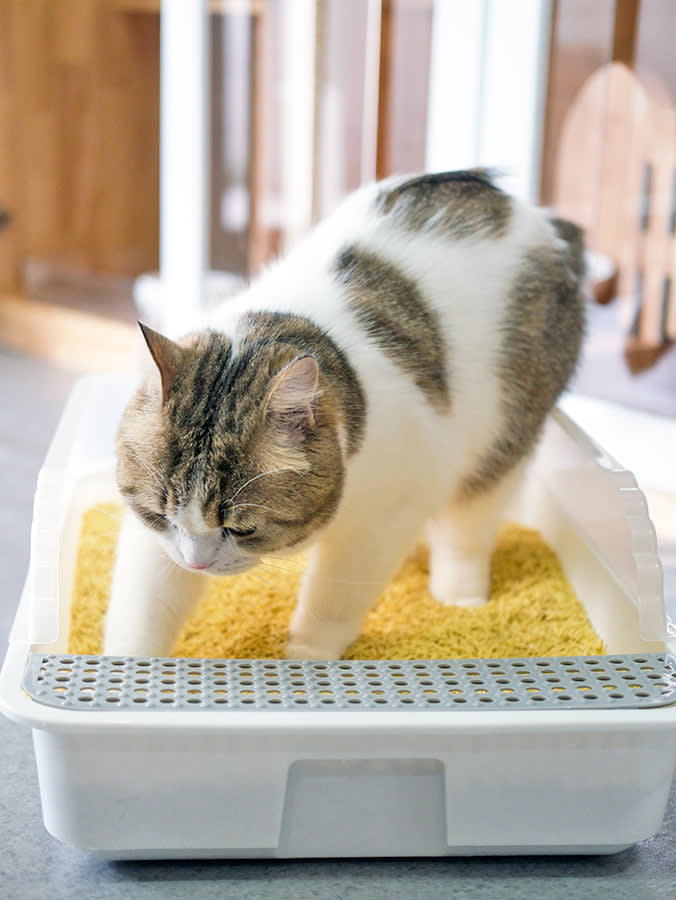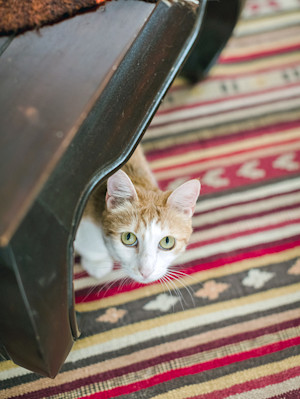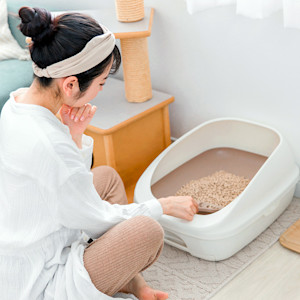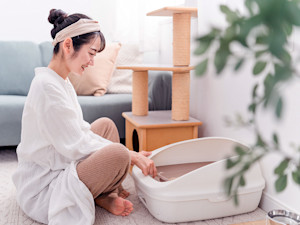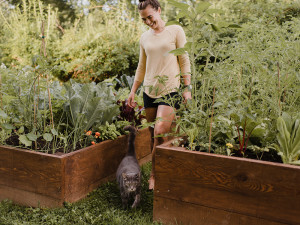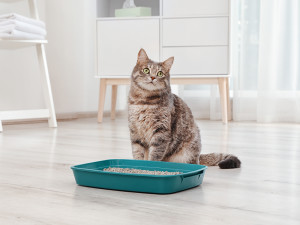Everything You Need to Know About Cat Poop
Because we do have to talk about it... sometimes.
In This Article:
What Does Healthy Cat Poop Look Like? Signs of Unhealthy Cat Poop Common Causes of Digestive Issues in Cats How Vets Diagnose Digestive Issues Tips for Maintaining Healthy Digestion
Your cat’s poop may not be your favorite topic, but it holds valuable insights into their health. From texture to color, understanding what’s normal and what’s not can help you catch potential health issues early. If you’re scooping the litter box, you’re already getting up close and personal with your cat’s poop. Knowing what to watch for can help you keep your cat happy and healthy.
What does healthy cat poop look like?
Healthy cat pop should be sausage-shaped and medium-brown in color. While a little variation in bowel movements is expected, consistently normal poop can be a useful indicator of good digestive health. Here’s what to look for:
How much do you spend on your pet per year?
Color
Normal cat poop is medium to deep brown in color. The shade of brown can vary slightly depending on the individual cat, their diet, and how long their poop has been sitting and drying out. Changes in color can signal an issue.
Black or “tarry”: Melena, which is the medical term for dark blood in the stool, could indicate bleeding somewhere in a cat’s upper gastrointestinal tract — like the esophagus, stomach, or early in the small intestines. The blood is digested as it moves through the gut, causing a dramatic color change. Melena can be caused by bleeding ulcers, tumors, hookworms, or blood-clotting issues.
Red: Bright red blood in the stool (called hematochezia) is an indication of bleeding somewhere lower in the gastrointestinal tract, like the colon, rectum, or anus. Red stool or streaks of red could be an indication of severe inflammation, intestinal parasites, cancer, or trauma.
Gray: Gray and greasy poop can be a sign of an issue with the pancreas or gall bladder. Gray and dry stool can be seen in some constipated cats.
Green, yellow, or orange: Cat poop that has a tinge of green, yellow, or orange could be the result of underlying liver or gallbladder disease, parasites, or an infection.
Green, yellow, or orange: Cat poop that has a tinge of green, yellow, or orange could be the result of underlying liver or gallbladder disease.
Consistency
A cat’s poop should be firm enough to come out in formed pieces but soft enough to pass without significant straining. Stress or diet change can cause stool to be softer than normal, but this change should pass quickly. Some changes to the consistency of a cat’s poop that could indicate problems include:
Watery: If the gastrointestinal tract is inflamed, it won’t be able to absorb water effectively, leading to cat diarrhea. Reasons for inflammation include intestinal parasites, digestive disease, and bacterial or viral infections.
Soft or mushy: A cat’s poop can get a little mushy if they have an upset stomach, which can develop from stress, diet change, and dietary indiscretion.
Hard: Hard, dry stool could mean that your cat is dehydrated or constipated. Cats can become dehydrated secondary to low water intake or water loss from vomiting or diarrhea. Dehydration is the number one cause of constipation in cats, but it can also develop secondary to medications, inadequate fiber intake, or litter box avoidance. Parents of senior cats should know that arthritis pain can cause a cat to avoid the litter box, increasing their risk for developing constipation.
Content
Healthy cat poop only contains poop — nothing else.
Intestinal worms: Tapeworms and roundworms can appear in the stool of cats, especially if they have a heavy worm burden. Tapeworms appear as small, white, rice-like worms on the stool and are the result of flea ingestion. Roundworms are long, thin, spaghetti-like worms.
Foreign material: If you spot any non-food objects in your cat’s poop, that’s a sign that your cat is eating things they shouldn’t, and it’s time to be more diligent about what they have access to. The alternative is foreign material getting stuck in your cat’s gastrointestinal tract, causing an obstruction. This is typically a surgical problem, so it’s best to focus on prevention.
Hair: Of course your cat will ingest a little bit of hair whenever they bathe themselves, but that should never lead to wads of fur in their stool. Noticeable amounts of hair in the stool in combination with evidence of hair loss can be a sign of excessive grooming, which can be caused by allergies, parasites, stress, or anxiety.
Size and shape
Healthy cat poop should generally maintain a cylindrical shape.
Small pellets: If your cat is straining and only passing little poop pellets, they may be constipated.
Ribbon-shaped: Thin strips on stool can indicate narrowing of the colon, which can occur with severe inflammation, anal gland issues, or cancer.
Smell
Of course, nobody loves the smell of cat poop, but the odor shouldn’t be so offensive that it makes you gag. A strong, offensive odor is often a sign of intestinal parasites or bacterial overgrowth. I personally find the smell of cat poop infected with Coccidia or Tritrichomonas foetus (two species of single-celled protozoa) to be particularly heinous.
Signs of unhealthy cat poop
Abrupt changes in a cat’s stool often indicate underlying digestive issues. Pay close attention to your cat’s food and water intake, energy level, and litter box habits if their poop doesn’t look quite right. Unhealthy cat poop signs include:
Color changes
Consistency changes
Foreign material
Parasites
Frequent defecation
Straining to defecate
Common causes of digestive issues in cats
Several factors can lead to abnormal poop in cats, and not all of them stem from the gastrointestinal tract. Causes of digestive problems in cats include:
Dietary changes
Any change in diet can cause digestive issues in cats, even when switching from one high-quality food to another. Try to ease any gastrointestinal disruption by transitioning to a new diet over seven to 10 days.
Food allergies or intolerances
Cats can be allergic or sensitive to specific proteins or other ingredients in food, causing significant changes to their stool. Symptoms of food allergies or food intolerance can include diarrhea, vomiting, flatulence, and itchy skin.
Parasites
Any intestinal parasite can trigger inflammation in the gut, leading to soft stool or diarrhea — the most common symptom of intestinal worms in cats. Intestinal parasites can also cause changes in the color or content of a cat’s poop. For example, hookworms feed on blood and can cause intestinal bleeding and color change. Roundworms and tapeworms can be visible in the feces.
Stress
Stress can cause temporary stomach upset in cats, especially cats with irritable bowel syndrome. Common stressors in cats include new people, new pets, and drastic changes in their environment or routine.
Dietary indiscretion
Many people like to blame dogs for eating things they shouldn’t, but cats aren’t completely innocent when it comes to this behavior. Cats are no strangers to eating insects, plants, garbage, or inanimate objects, which can all lead to gastroenteritis.
Inflammatory bowel disease
Inflammatory bowel disease (IBD) in cats is a condition in which the gastrointestinal tract suffers from chronic inflammation, leading to symptoms like diarrhea, bloody stool, vomiting, and weight loss.
Organ disease
Organ diseases like kidney disease, liver disease, and pancreatitis can all cause non-specific symptoms, including loose stool, vomiting, and poor appetite.
Cancer
Certain cancers can infiltrate the walls of the gastrointestinal tract and impair digestion. Others can form tumors, making the passage of food and stool more difficult.
How vets diagnose digestive issues
When abnormalities in your cat’s poop are persistent or dramatic, it’s time to see a vet. This is a situation where a medical history and a cat parent’s at-home observations are super handy. If a cat goes from having normal bathroom habits to releasing foul-smelling juicy poops five times a day, that’s important information that should be investigated.
Because so many different health issues can cause loose stool or other changes in a cat’s poop, testing may be recommended. Tests for abnormal cat feces may include:
Physical exam
Fecal exam
Blood work
Imaging (X-rays or ultrasound)
Endoscopy
Intestinal biopsy
Tips for maintaining healthy digestion
Focusing on your cat’s overall health and wellbeing is the best way to try to prevent digestive disturbances. These are some healthy digestion tips for cats:
Feed your cat a high-quality, balanced diet that’s appropriate for their age, lifestyle, and health status.
Make sure your cat has access to fresh water at all times.
Scoop and clean the litter box regularly to help prevent litter box avoidance.
Pay attention to the color, consistency, and content of your cat’s poop while scooping.
Perform routine deworming and preventative care to prevent intestinal parasites and preventable disease.
Try to provide a stress-free environment for your cat.
Provide a low-sided litter box for cats with arthritis or other orthopedic issues.
Bottom line: Healthy cat digestion
A cat’s poop provides important clues about their overall health. Healthy poop is well-formed, medium brown in color, and does not contain any foreign material. Color, consistency, or odor changes might indicate digestive problems, dietary issues, or underlying health concerns. Always consult a vet if you notice unusual symptoms.
References
DVM, Ed Branam. “Symptomatic Management of Primary Acute Gastroenteritis in Dogs and Cats.” Today’s Veterinary Practice, 28 Nov. 2015, todaysveterinarypractice.com/gastroenterology/6716-2/opens in new tab.
